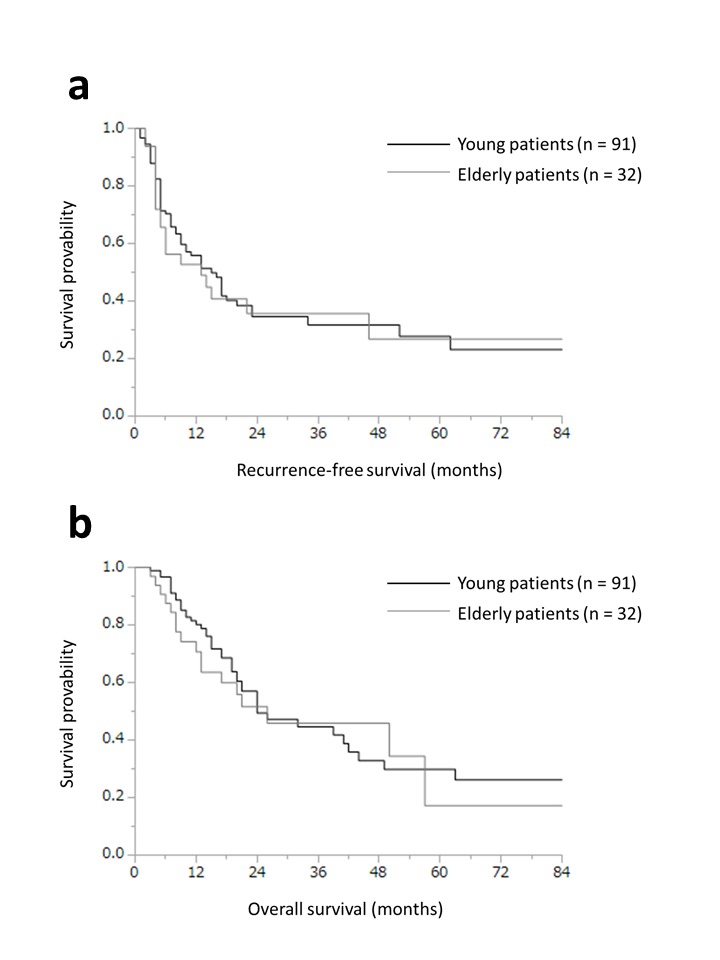|
Back to 2018 Posters
LONG-TERM OUTCOMES AFTER PANCREATECTOMY FOR PANCREATIC DUCTAL ADENOCARCINOMA IN ELDERLY PATIENTS: SPECIAL REFERENCE TO POSTOPERATIVE ADJUVANT CHEMOTHERAPY
Yusuke Watanabe*, Sho Endo, Kazuyoshi Nishihara, Toru Nakano
Department of Surgery, Kitakyushu Municipal Medical Center, Kitakyushu, Japan
Background: The benefit of pancreatectomy for elderly patients with pancreatic ductal adenocarcinoma (PDAC) remains controversial. Moreover, postoperative adjuvant chemotherapy (AC) for elderly patients has not been fully evaluated. The most common adverse events are dose-dependent, and elderly patients with functional impairment have a higher risk of adverse effect. The aim of this study was to investigate the short- and long-term outcomes after pancreatectomy in elderly patients with PDAC with special reference to AC.
Methods: The medical records of 123 patients who underwent pancreatectomy for PDAC from 2007 to 2016 were retrospectively reviewed. The patients were divided into 2 groups: young (<75 years) and elderly patients (≥75 years).
Results: The study population comprised 91 young and 32 elderly patients. The postoperative complication rate, hospital stay, and the medical cost during hospitalization were not different between the 2 groups. AC was given to 98 patients (gemcitabine in 37, tegafur/gimeracil/oteracil potassium (S1) in 60, and gemcitabine plus S1 in 1). AC was more frequently administered to young patients (n = 77, 85%) than elderly patients (n = 21, 66%; P = 0.04). The interval from pancreatectomy to starting AC tended to be shorter in young patients (median, 38 days; range, 15-163 days) than in elderly patients (median, 52 days; range, 18-93 days; P = 0.11). Creatinine clearance was significantly lower in elderly (median, 77.2 ml/min; range, 42.3-119.9 ml/min) than in young patients (median, 93.4 ml/min; range, 57.3-158.1 ml/min; P < 0.01). The weekly dose of gemcitabine tended to be lower in elderly patients (median, 798 mg/m2; range, 693-993 mg/m2) than young patients (median, 955 mg/m2; range, 579-1000 mg/m2; P = 0.15). The weekly dose of S1 was significantly lower in elderly (median, 423 mg/m2; range, 342-541 mg/m2) than young patients (median, 491 mg/m2; range, 321-559 mg/m2; P = 0.02). The prevalence of adverse events and the completion rate of AC were not significantly different between the 2 groups. There were no significant differences in recurrence-free survival (P = 0.73) or overall survival (P = 0.68) between the 2 groups. Tumor size, postoperative complications, and completion of planned AC were significant independent factors for recurrence-free survival. Age, preoperative biliary drainage, tumor size, postoperative complications, and completion of planned AC were significant independent factors for overall survival.
Conclusion: Pancreatectomy for PDAC can be performed safely even in elderly patients, and old age alone might not be a contraindication for pancreatectomy for PDAC according to both long- and short-term outcomes. Low-dose AC using S1 for elderly patients might be safe and therapeutically useful. When tolerability might be improved by tailored-dose AC, more elderly patients may be able to receive AC.
Postoperative course and adjuvant chemotherapy
| | Overalll patients
(n = 123) | Young patients
(n = 91) | Eldery patients
(n = 32) | | | value | % | Value | % | Value | % | P value | | Clinically relevant complications* | 28 | 23 | 22 | 24 | 6 | 19 | 0.63 | | Pancreatic fistula | 24 | 20 | 19 | 21 | 5 | 16 | 0.62 | | Abdominal abscess | 8 | 7 | 5 | 5 | 3 | 9 | 0.43 | | Hemorrhage | 3 | 2 | 3 | 3 | 0 | 0 | 0.57 | | Bile leakage | 2 | 2 | 1 | 1 | 1 | 3 | 0.45 | | Enteral nanastomosisi leakage | 1 | 1 | 1 | 1 | 0 | 0 | 1.00 | | Bowel obstruction | 1 | 1 | 1 | 1 | 0 | 0 | 1.00 | | Hospital stay, days | 24 (7-139) | | 24 (7-116) | | 24 (12-139) | | 0.93 | | Medical cost, 10000 yen | 263 (138-764) | | 265 (138-764) | | 258 (!49-452) | | 0.56 | | Adjuvant chemotherapy | 98 | 80 | 77 | 85 | 21 | 66 | 0.04 | | Interval from pancreatectomy to starting adjuvant chemotherapy, days | 43 (15-163) | | 38 (15-163) | | 52 (18-93) | | 0.11 | | Regimen of adjuvant chemotherapy | | | | | | | 0.12 | | Gemcitabine | 37 | 30 | 30 | 33 | 7 | 22 | | | S1 | 60 | 49 | 46 | 51 | 14 | 44 | | | Gemcitabine + S1 | 1 | 1 | 1 | 1 | 0 | 0 | | | Weekly dose of adjuvant chemotherapy | | | | | | | | | Gemcitabine, mg/m2 | 948 (579-1000) | | 955 (579-1000) | | 798 (693-993) | | 0.15 | | S1, mg/m2 | 483 (321-559) | | 491 (321-559) | | 423 (342-541) | | 0.02 | | Completion of planned adjuvant chemotherapy | 55 | 45 | 45 | 49 | 10 | 31 | 0.10 |
Data are expressed as median (range) or number of patients S1 tegafur/gimeracil/oteracil potassium *Complications occasionally overlapped among the patients  Survival curves of elderly patients (n = 32) vs. young patients (n = 91). a Recurrence-free survival ( P = 0.73). b Overall survival (P = 0.68).
Back to 2018 Posters
|

